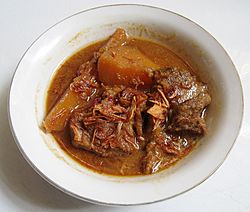Semur (Indonesian stew) facts for kids

Semur daging with potatoes, sprinkled with fried shallots
|
|
| Alternative names | Smoor (Dutch dialect) |
|---|---|
| Course | Main course |
| Place of origin | Indonesia |
| Region or state | Southeast Asia |
| Serving temperature | Hot or room temperature |
| Main ingredients | Beef and potatoes simmered in sweet soy sauce, with garlic, shallot, nutmeg, cloves, and cinnamon, topped with fried shallot |
| Variations | Beef tongue, chicken, tofu, eggs, fish |
Semur is a delicious Indonesian stew, usually made with beef. You can find it all over Indonesia. The main ingredients for its rich, brown sauce are sweet soy sauce, shallots, onions, garlic, ginger, candlenuts, nutmeg, and cloves. Sometimes, people also add black pepper, coriander, cumin, and cinnamon.
Sweet soy sauce is super important for semur. It gives the dish its special flavor, making it sweet and savory at the same time. Besides beef, semur can be made with many other things. Some popular choices include beef tongue, potatoes, tofu, tomatoes, tempeh, eggs, chicken, or even fish! Often, it's topped with crispy fried shallots.
Contents
What Does Semur Mean?
The name semur comes from the Dutch word "smoren". This word means "to braise food." Braising is a cooking method where food is first lightly fried, then slowly cooked in a small amount of liquid in a covered pot.
The Story of Semur
How Old Is This Dish?
People in ancient Java, Indonesia, have been cooking marinated meat dishes since the 9th century CE. Old writings and temple carvings mention "buffaloes and goats served with vegetables." We don't know for sure if these were exactly like today's stews, but it shows a long history of cooking meat in Indonesia.
Spices and New Ideas
For hundreds of years, traders from all over the world came to Indonesia. They were looking for amazing spices like nutmeg, cloves, and cinnamon. These traders and new settlers brought their own cultures and cooking styles. Over time, these different traditions mixed with Indonesian ways.
The Dutch, who were in Indonesia for a long time, brought their stew-making techniques. They combined these with local Indonesian spices and the special sweet soy sauce. This sweet soy sauce is dark and made with caramelized palm sugar. This mix of foreign cooking methods and local flavors created unique dishes like semur, which became popular around the 1600s.
Semur Becomes Indonesian
The Dutch word smoor (meaning "stew") became the root for semur. Smoor in Dutch cooking meant food slowly cooked with tomatoes and onions. An old cookbook from 1902, called Groot Nieuw Oost-Indisch Volledig Kookboek, had many smoor recipes. This shows that smoor stew was a cooking style that grew in Indonesia, especially among people of mixed European and Indonesian heritage.
Over time, semur became a big part of Indonesian traditions. Javanese people, who love sweet flavors, really enjoy semur. The Betawi people in Jakarta serve semur at important celebrations like Lebaran (a big holiday) and weddings. They even have a special semur jengkol, which is a stew made from jengkol (a type of bean). Semur is also popular in other parts of Indonesia, like Kalimantan and Sumatra, with flavors that fit local tastes.
At first, semur was mostly about beef in a thick brown sauce. But it grew to include many other ingredients. Today, you can find semur made with ox tongue, mutton, chicken, eggs, tofu, tempeh, and even eggplant. Semur is now a common meal in Indonesian homes and is enjoyed all across the country.
Semur can be eaten on its own with rice, or with lontong (rice cakes). It can also be part of a bigger meal like a rijsttafel (a Dutch-Indonesian buffet), or served as a side dish with tumpeng (a cone-shaped rice dish), nasi uduk (coconut rice), or nasi rames (mixed rice).
Different Kinds of Semur
- Semur daging or semur jawa: This is the most common type, usually made with beef and potatoes. It's very popular in Java.
- Semur betawi: This semur comes from the Betawi people in Jakarta. It often has beef, potatoes, and eggs, with slightly different spices.
- Semur ayam: This is a chicken semur, also very common in Java.
- Semur jengkol: A semur made with jengkol (a type of bean). It's popular in Jakarta and West Java.
- Semur manado: This semur is from Manado in North Sulawesi.
- Semur banjar: A semur from Banjarmasin in South Kalimantan.
- Semur lidah: This is a semur made with beef tongue.
- Semur aceh: A beef semur from Aceh.
- Semur goreng samarinda: This is a fried semur from Samarinda.
- Semur ikan purwokerto: A fish semur from Purwokerto.
- Semur ternate: This semur from Ternate has vinegar added to it.
- Semur kelapa: A coconut semur from Maluku.
- Semur terong tahu: This semur from West Java is made with eggplant and tofu.
Images for kids
-
Meat dishes of Indonesia sold in Netherlands, rendang, smoor, and Bali-style meat


